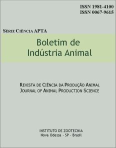Epidemiologia da nosemose em abelhas africanizadas (Apis mellifera L.) na região de Pindamonhangaba, SP
Palavras-chave:
protozoose, patologia, nosemose, Nosema apis, Apis melliferaResumo
Esporos do protozoário Nosema apis Zander estão presentes em muitos apiários brasileiros durante todo o ano e quando as condições ambientais e o nível de susceptibilidade das abelhas são favoráveis, o parasito pode multiplicar-se rapidamente, aparecendo, então, os sintomas característicos da doença denominada de nosemose, tais como, dilatação do abdome, diarréia e morte. O trabalho foi realizado com o objetivo de determinar a intensidade de infestação natural e sua flutuação ao longo do ano, para avaliação dos prejuízos causados à produção apícola da região, bem como, subsidiar o estabelecimento de um programa de tratamento preventivo da doença. Foram tomadas , em intervalos quinzenais durante dois anos, amostras de cerca de 200 abelhas em 5 colônias de abelhas africanizadas, sorteadas entre as 50 do apiário experimental do Centro de Apicultura Tropical. De cada amostra foram destacados os intestinos de 35 abelhas, triturados e contado em heimocitômetro, o número de esporos de N. apis/mm3 do conteúdo intestinal. Verificou-se que de janeiro a março e de outubro a dezembro a incidência de esporos é muito baixa e mesmo no período de maior infestação (abril a setembro) a infestação é muito inferior ao nível de 1 X 106 esporos/mm3, capaz de causar mortalidade em abelhas quando esta taxa de infestação permanece por mais de quinze dias. Pode-se concluir que para a região de Pindamonhangaba, SP, não é necessário tratamento preventivo para esta enfermidade.Downloads
Downloads
Publicado
Edição
Seção
Licença
Os autores não serão remunerados pela publicação de trabalhos, pois devem abrir mão de seus direitos autorais em favor deste periódico. Por outro lado, os autores ficam autorizados a publicar seus artigos, simultaneamente, em repositórios da instituição de sua origem, desde que citada a fonte da publicação original seja Boletim de Indústria Animal. A revista se reserva o direito de efetuar, nos originais, alterações de ordem normativa, ortográfica e gramatical, com vistas a manter o padrão culto da língua e a credibilidade do veículo. Respeitará, no entanto, o estilo de escrever dos autores. Alterações, correções ou sugestões de ordem conceitual serão encaminhadas aos autores, quando necessário. Nesses casos, os artigos, depois de adequados, deverão ser submetidos a nova apreciação. As opiniões emitidas pelos autores dos artigos são de sua exclusiva responsabilidade. Todo o conteúdo deste periódico, exceto onde está identificado, está licenciado sob a Licença Creative Commons Attribution (CC-BY-NC). A condição BY implica que os licenciados podem copiar, distribuir, exibir e executar a obra e fazer trabalhos derivados com base em que só se dão o autor ou licenciante os créditos na forma especificada por estes. A cláusula NC significa que os licenciados podem copiar, distribuir, exibir e executar a obra e fazer trabalhos derivados com base apenas para fins não comerciais.













